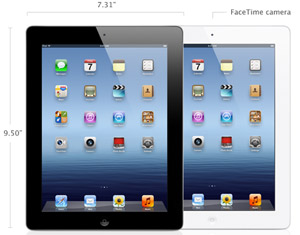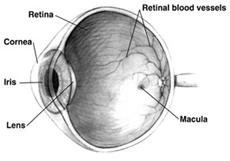Create a free profile to get unlimited access to exclusive videos, sweepstakes, and more!
Eyeballing the iPad 3 retina display

 Today, Apple announced the new iPad 3, which has a bunch of new features and improvements over the iPad2. One of the new features is a much higher resolution display: 2048 x 1536 pixels, which they advertise as a "retina" display: ad-speak for pixels so small your eye can't see them. The display looks smooth and unpixellated.
Today, Apple announced the new iPad 3, which has a bunch of new features and improvements over the iPad2. One of the new features is a much higher resolution display: 2048 x 1536 pixels, which they advertise as a "retina" display: ad-speak for pixels so small your eye can't see them. The display looks smooth and unpixellated.
But is that really the case? I did a little math and found this claim to be true, more or less. But there are some caveats, and they're interesting.
[By the way: I've done the math here in imperial units, and not metric, because that's the standard the industry uses for pixels and such. Silly, but it's one of the last holdouts you'll see used this way.]
iBalling the numbers
First, you should really read my post Resolving the iPhone resolution, where I first dissected the "retina display" claim for when the iPhone 4 came out. My conclusion then was that yes, the iPhone 4 display has pixels so small you can't see them under normal circumstances. But in that post I did a bit of math to prove it.
What I found was that if you hold a device about a foot away from your face and have normal vision, the pixels need to be smaller than 0.0035 inches in size for them to be unresolved; in other words, pixels at this size or smaller give you a "retina display". The iPhone 4 has pixels about 0.0031 inches in size, so it wins.
But what about the new iPad?
Ah, iSee
The new iPad is reported to be the same size as the iPad 2, with a display of 7.75 x 5.8 inches. But it does have smaller pixels than the old version! Dividing the size of the display by the number of pixels (2048 x 1536) we get a pixel size of 0.0038 inches (or 264 dots per inch, if you prefer).
Uh oh. That's actually a bit bigger than what your eye can see! So is this truly a "retina display"?
 Well, let's not be too hasty to poo-poo this new tech. For one thing, the iPad display is only resolved if you hold it a foot or closer to your eyes. After a little testing, I found that I tend to hold my own iPad 2 about 15 - 17 inches from my face. From that distance (let's call it 16 inches), pixels need to be smaller than 0.0047 inches to be unresolved (again, see my old post about how that works and where that number comes from), and the iPad 3's pixels are certainly smaller than that!
Well, let's not be too hasty to poo-poo this new tech. For one thing, the iPad display is only resolved if you hold it a foot or closer to your eyes. After a little testing, I found that I tend to hold my own iPad 2 about 15 - 17 inches from my face. From that distance (let's call it 16 inches), pixels need to be smaller than 0.0047 inches to be unresolved (again, see my old post about how that works and where that number comes from), and the iPad 3's pixels are certainly smaller than that!
If you do happen to have perfect eyes, under ideal circumstances you'll probably be able to see the pixellation in the screen, but it won't be that big a deal, I'd wager -- and if you hold the iPad 3 about 18 inches from your face, the pixels are too small to see in any case. So, for the majority of people, the claim of a "retina display" is probably accurate.
I'll note, though, that the iPad 3 pixels are larger than those for the iPhone 4. But that's OK; I tend to hold the iPhone a little closer to my eyes than I do the iPad. In either case, I'm unlikely to see the pixels.
I imagine there will be a lot of writing about the display for the iPad 3, with some people loving it and others hating it -- that's inevitable when new tech comes out, especially when Apple is behind it (I'll note my original resolution post was in response to what I thought was an unfair denigration of the iPhone 4's display). Incidentally, Boing Boing reports the new iPad will have 40% more color saturation. A display with more colors can trick the eye into thinking the resolution is better, so this will also help the "retina display" claim.
And yes, duh, of course I want one! But I tend not to jump into new tech, and besides, I got the iPad 2 just a few months ago. I like it, and it's fine for me; the new features are not anywhere near enough for me to want to spend the money to upgrade. Hopefully, my iPad 2 will last long enough that when the iPad 4 comes out, by then I'll be ready.
Image credits: Apple; wikipedia. Note: I had incorrectly called this a "retinal display", so I have corrected the text. Thx to huggyb for pointing this out.
Related Posts:
- Resolving the iPhone resolution
- Moon Hoax: Why not use telescopes to look at the landers?
- My New Years Resolution














